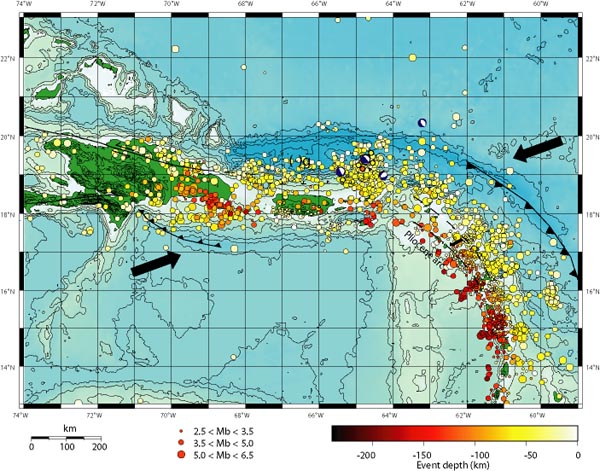Tropical Storm Chantal is strengthening as it speeds west-northwestwards at 26 mph through the Lesser Antilles Islands. At 6:22 am AST, St. Lucia recorded a wind gust of 54 mph. Sustained winds of 38 mph, gusting to 52 mph, were observed at Martinique at 10 am AST. An Air Force hurricane hunter aircraft is in the storm, and measured top winds at their 1,000′ flight level of 80 mph at 8:41 am AST, about 20 miles north of the center. Top winds seen by the aircraft’s SFMR instrument were about 60 mph, and it is likely that NHC will bump up Chantal’s top winds to at least 60 mph in their 11 am advisory. Barbados Radar shows a large area of heavy rain that has organized moderately well into low-level spiral bands affecting much of the central Lesser Antilles Islands. Chantal is not very impressive on satellite loops, though, with only a modest amount of heavy thunderstorms that are not well-organized. Only a small amount of upper-level outflow is visible. Chantal is fighting dry air associated with the Saharan Air Layer (SAL), as seen on water vapor satellite loops. Moderate wind shear of 15 – 20 knots is driving dry air into the storm. Ocean temperatures are fairly warm, at 28°C.
![]()
Figure 1. Latest satellite image of Chantal.
![]()
Figure 2. Barbados weather radar image of Chantal taken at 9:14 am AST on Tuesday, July 9, 2013. Chantal’s center was located between St. Lucia and Martinique. Image credit: Barbados Met Service.
Forecast for Chantal
Chantal will likely continue to intensify before hitting Hispaniola on Wednesday afternoon. In their 5 am EDT wind probability forecast, NHC gave Chantal a 23% chance of becoming a hurricane before hitting Hispaniola. Working against intensification will be the fast forward speed of the storm–tropical storms moving faster than 20 mph in the deep tropics usually have trouble intensifying. In addition, the Eastern Caribbean is an area where the trade winds accelerate, helping drive sinking air that discourages tropical storm intensification. Dry air will also slow down the intensification process. Interaction with the high mountains of Hispaniola and high wind shear may be able to destroy Chantal by Thursday. The 8 am EDT Tuesday wind shear forecast from the SHIPS model calls for shear to rise to the high range, 20 – 30 knots, as the storm approaches and crosses Hispaniola on Wednesday and Thursday. On Friday and Saturday, when Chantal is expected to be in the Bahamas, lower moderate wind shear of 15 – 20 knots should allow for re-intensification of the storm–if it survives interaction with the high mountains of Hispaniola, Puerto Rico, and Eastern Cuba. The latest 06Z run of the GFS model dissipates Chantal as it crosses Hispaniola, though the 00Z run done 6 hours earlier had the storm surviving. Chantal has the potential to cause big problems for Haiti, which is highly vulnerable to flash flooding due to the lack of vegetation on the deforested mountains. However, there is a lot of dry air to the west of Chantal, which may act to keep rainfall totals in Haiti down to a manageable 2 – 4″. Over 300,000 people are still homeless and living in makeshift tent camps in Haiti, three years after the great 2010 earthquake.
Chantal’s fast west-northwest forward speed of 26 mph will slow to 20 mph by Wednesday afternoon and then 10 mph by Thursday afternoon, as the storm “feels” the presence of a trough of low pressure over the U.S. East Coast. This trough will steer Chantal to the northwest and then north-northwest across Hispaniola and into the Bahamas. The trough of low pressure pulling Chantal northwards is expected to lift out the the northeast over the weekend, leaving Chantal behind off the coast of Florida. High pressure will likely build in, potentially forcing an intensifying Chantal westwards into the Florida or Southeast U.S. coast, with a possible Monday landfall.
from: http://www.wunderground.com/blog/JeffMasters/show.html






